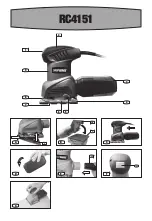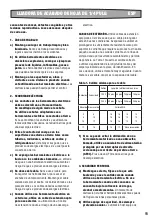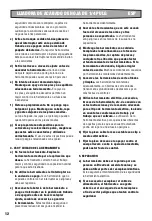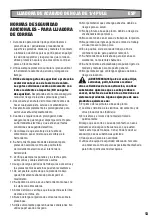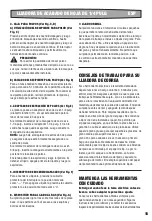
5
1/4 IN. SHEET FINISHING SANDER
ENG
1. WORK AREA SAFETY
a) Keep work area clean and well lit.
Cluttered or
dark areas invite accidents.
b) Do not operate power tools in explosive
atmospheres, such as in the presence of
flammable liquids, gases or dust.
Power tools
create sparks which may ignite the dust or fumes.
c) Keep children and bystanders away while
operating a power tool.
Distractions can cause
you to lose control.
2. ELECTRICAL SAFETY
a) Power tool plugs must match the outlet. Never
modify the plug in any way. Do not use any
adapter plugs with grounded power tools.
Unmodified plugs and matching outlets will reduce
risk of electric shock.
b) Avoid body contact with grounded surfaces
such as pipes, radiators, ranges and
refrigerators.
There is an increased risk of electric
shock if your body is earthed or grounded.
c) Do not expose power tools to rain or wet
conditions.
Water entering a power tool will
increase the risk of electric shock.
d) Do not abuse the cord. Never use the cord
for carrying, pulling or unplugging the power
tool. Keep cord away from heat, oil, sharp
edges or moving parts.
Damaged or entangled
cords increase the risk of electric shock.
e) When operating a power tool outdoors, use
an extension cord suitable for outdoor use
marked “W-A” or “W”.
Use of a cord suitable for
outdoor use reduces the risk of electric shock.
USE PROPER EXTENSION CORD.
Make sure your
extension cord is in good condition. When using an
extension cord, be sure to use one heavy enough to
carry the current your product will draw. An undersized
cord will cause a drop in line voltage resulting in loss of
power and overheating. Table 1 shows the correct size
to use depending on cord length and nameplate ampere
rating. If in doubt, use the next heavier gage. The
smaller the gage number, the heavier the cord.
Table 1 Minimum gage for cord
Ampere
Rating
Volts
Total length of cord in feet
120 V
25 ft.
50 ft.
100 ft.
150 ft.
More
Than
Not More
Than
AWG
0
6
10
6
10
12
18
18
16
16
16
16
16
14
14
14
12
12
12
16
14
12
Not Recommended
f) If operating a power tool in a damp location
is unavoidable, use a Ground Fault Circuit
Interupter (GFCI) protected supply.
Use of a
GFCI reduces the risk of electric shock.
3) PERSONAL SAFETY
a) Stay alert, watch what you are doing and
use common sense when operating a power
tool. Do not use a power tool while you are
tired or under the influence of drugs, alcohol
or medication.
A moment of inattention while
operating power tools may result in serious personal
injury.
b) Use personal protective equipment. Always
wear eye protection.
Protective equipment such
as dust mask, non-skid safety shoes, hard hat, or
hearing protection used for appropriate conditions
will reduce personal injuries.
c) Prevent unintentional starting. Ensure the
switch is in the off-position before connecting
to power source and/or battery pack, picking
up or carrying the tool.
Carrying power tools with
your finger on the switch or energizing power tools
that have the switch on invites accidents.
d) Remove any adjusting key or wrench before
turning the power tool on.
A wrench or a key left
attached to a rotating part of the power tool may
result in personal injury.
e) Do not overreach. Keep proper footing and
balance at all times.
This enables better control
of the power tool in unexpected situations.
f) Dress properly. Do not wear loose clothing or
jewelry. Keep your hair, clothing and gloves
away from moving parts.
Loose clothes, jewelry
or long hair can be caught in moving parts.
g) If devices are provided for the connection



